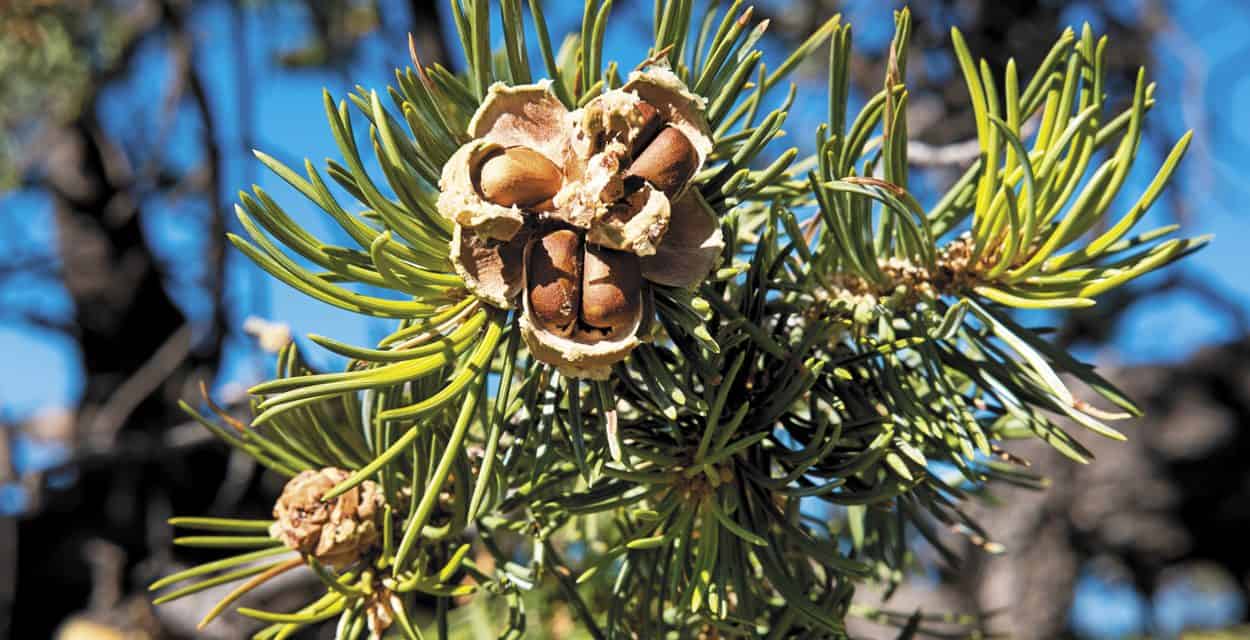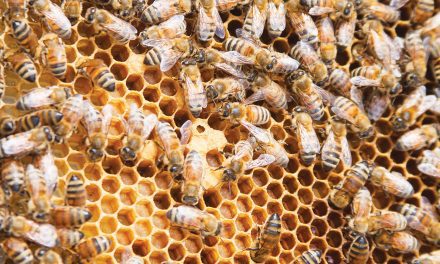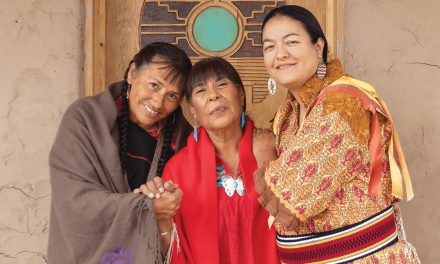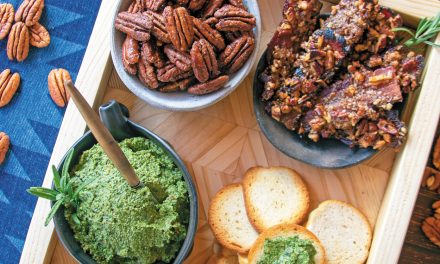By Annie Montes
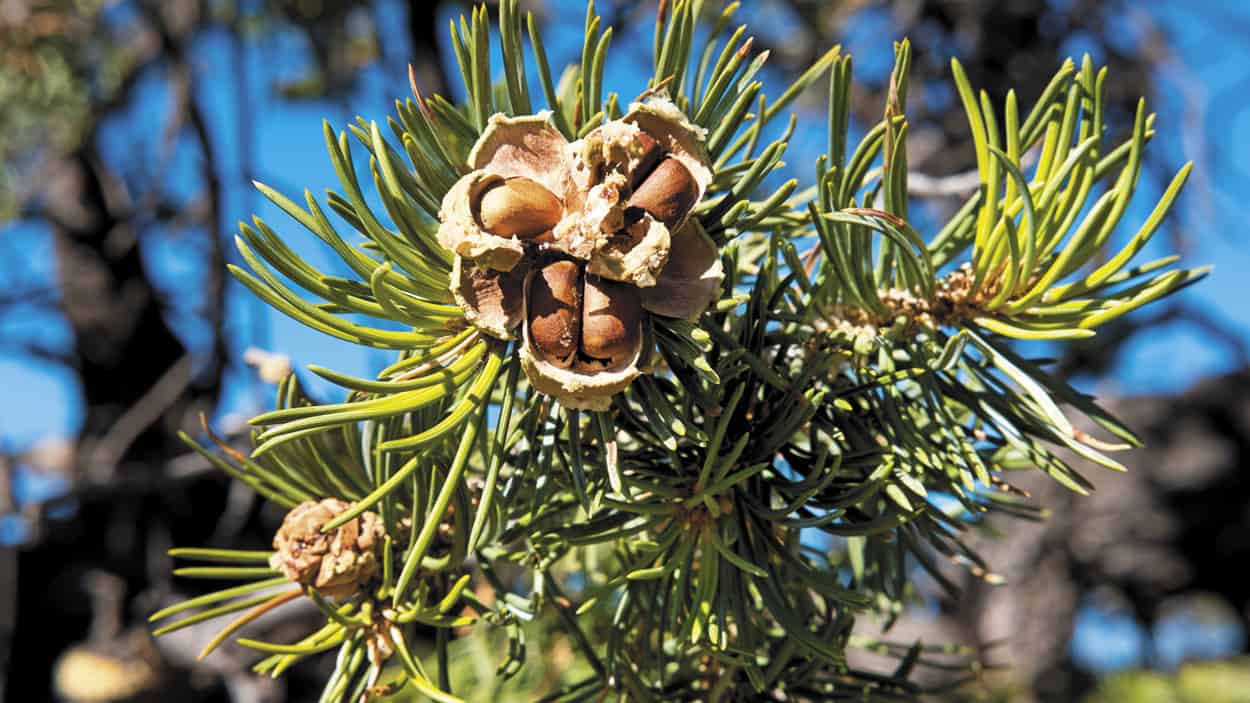
Piñon nuts in the cone of a piñon pine. Photo by Gail Ann Williams.
Two scents are prevalent in the olfactory memory of every New Mexican: the spicy, smoky smell of roasting chiles in the late summer and early autumn, and the sweet, woody scent of piñon burning in the winter. Walking in my neighborhood, I’ll often delight at the combination of these scents and be reminded of the complexities that go into growing, harvesting, and caring for both plants. Even more so, I think about the histories of these New Mexican favorites, how they got here, and how long they’ve been intertwined into the very fabric of New Mexican history. As much as New Mexicans love to argue over red or green, our relationship with piñon has centuries of advantage over that with the Hatch chile; we’ve been co-evolving with piñon for thousands of years, while what we know as the Hatch chile has only been with us since the twentieth century.
Piñon is more deeply woven into local history than statehood itself. It appears in the stories of the Hopi and Laguna people and has been found in hallmark historic locations including Chaco Canyon, El Morro, and Bandelier. For millennia, piñon has provided many gifts for all who interact with it, including food, shelter, and warmth. Humans enjoy piñon nuts so much that a pound can cost as much as eighty dollars today, more than twenty times the price we pay for peanuts. We aren’t the only ones who enjoy the tasty bounty of these trees, though. A plethora of other living beings consume some part of piñon, including various rodents, birds, insects, and even fungi. The piñon jay and piñon dwarf mistletoe, among many others, depend on the presence of this tree for their very survival.
In addition to nut production, piñon also provides habitat for wildlife and firewood for people who heat their homes with wood-burning stoves. Pack rats, common rodents in the Southwest, and piñon jays rely on this tree for nesting and reproduction: pack rats collect piñon wood for their nests, or middens, and piñon jays use nuts in their courting rituals. Not only does piñon wood have a pleasant smell, it burns longer than other firewood alternatives, can be readily found locally, and ignites easily—which accounts for its popularity as a heating source. In McKinley County, roughly 40 percent of all homes are heated by wood-burning stoves.
Piñon’s relationship to mycorrhizal fungi runs even deeper (figuratively and literally) than its relationship with animals or people. During my undergraduate studies, I learned that these fungal associates serve as extensions of the piñon’s roots. Because these fungi are made up of microscopic strands of cells, also known as hyphae, they can explore for nutrients in soil much more effectively than plants. (The relationship between mycorrhizal fungi and plants is so beneficial that mycorrhizae are associated with 90 percent of plant families.) They move nutrients and water through this network of hyphae back to the root tips of the plant partner. The plant then trades sugars made from photosynthesis with its fungal partner.
The fate of each partner in this mutualism became intertwined millions of years ago, yet so much must happen to make this relationship work. When a piñon seed, or any seed for that matter, germinates, it first sends a root down into the soil to begin collecting water and anchoring itself for the stems to come. As roots grow, they leak a discharge containing chemical signals into the surrounding soil. These chemicals can act to inhibit harmful microbes and attract beneficial ones, including compatible mycorrhizal fungi. Every plant species sends different signals, and in the soil the microscopic mycorrhizal spores wait patiently for a match. Upon receiving a match, the spore awakens and begins to grow toward the root tip. The fungus must then ask the plant for permission to enter. If conditions are suitable, the root will allow the fungus to grow between or through the root’s cells and begin to form the machinery needed for nutrient exchange between the partners.

Piñon root tips colonized by a white mycorrhizal fungus at 10x magnification. Photo by Annie Montes.
Studies are finding that mycorrhizae do more than trade nutrients. They can act as a shield for the plant in times of need, providing drought tolerance and pathogen resistance, and potentially increasing a plant’s ability to survive in soils contaminated with pollution such as heavy metals. Many plants, including piñon, cannot survive without their mycorrhizal partners, nor can many mycorrhizal fungi survive without their plant host. Their relationship is physically binding and as obligate as that of a bee and a flower.
As climate change intensifies, mycorrhizae could be the difference between the adaptation and extinction of piñon. In Arizona and New Mexico alone, piñon death occurred on 136,000 acres in 2021, a nearly tenfold increase from the damage observed in 2020. Because piñon-juniper woodlands cover 100 million acres over ten states and make up the third-largest biome in the United States, it is a difficult ecosystem to ignore. In the Southwest, piñon mortality has already exceeded 2.5 million acres—and that’s only since the 1950s. It’s been estimated that some 350 million piñon trees have died just this century. These numbers are alarming for a tree that holds so much cultural, economic, and ecological importance.
Scientists have also recorded a decline in new seedling recruitment. This means that not only is piñon dying at remarkable rates, but seedlings are not establishing to replace dead adults. This could be attributed to the impacts of climate change, including increasing temperatures and drought as well as a lack of compatible mycorrhizal fungi in soils after piñon dies. I and others suspect that the persistence of these fungi in soils is key to the restoration of piñon-juniper woodlands. If that’s true, planting piñon stands on soils that lack these fungi would result in low to no survival of seedlings.
When I began my graduate degree at the University of New Mexico (UNM), I found that studies looking at the persistence of mycorrhizal fungi are rare, and findings may be inconsistent between different plant hosts due to the specificity of many mycorrhizal partners. This inspired me to design a piñon experiment looking at the persistence of compatible mycorrhizal fungi over time. To start this project, I first needed to find areas in New Mexico that contained stands of extirpated, or locally extinct, piñon. These sites might contain other trees, like juniper, but needed to lack piñon seedlings and be accessible for soil sampling.
I contacted the Albuquerque Bureau of Land Management (BLM) office for their vegetation treatment records. Digging through these records, I was able to locate several potential sites for my research. Reaching these sites turned out to be quite an adventure as I made my way through backcountry roads, pushing the limits of my old Subaru over lava rock, in slick mud, and through open meadows. The sites that I could safely access often had young piñon seedlings or adult trees. After two months of searching, I found two sites that met my criteria, where piñon had died off sixteen and sixty-four years ago. Because UNM has access to the Sevilleta National Wildlife Refuge, and extensive research has been conducted there, I was able to expand my search beyond BLM lands. My scouting missions went similarly on the Sevilleta and I encountered another challenge: Many of the soils were so shallow that I would hit bedrock after digging just a few centimeters down. To sample for mycorrhizal fungi, I needed to dig down to at least thirty centimeters. After digging hundreds of shallow holes, I found two more sites that were extirpated sixteen and fifty-six years ago. This was a good start, but I also wanted to find sites that were even older.
I found what I was looking for, it turned out, thanks in part to pack rat middens. Wood in these middens can be preserved by the pack rats’ urine, and each pack rat only collects wood within one hundred yards of its den. Knowing this, scientists have been able to carbon-date middens that were thousands of years old and estimate the approximate vegetation that occupied Chaco Canyon over the last eleven thousand years. This information allowed me to find two sites in Chaco Canyon where piñon had been extirpated approximately five hundred years ago.

From top left, clockwise: A passive vane bark beetle trap, photo by Gregory Reynolds. A soil sampling pit with markers at 5 cm and 20 cm, photo by Annie Montes. A bark beetle emergence trap, photo by Gregory Reynolds. A five-month-old piñon seedling, photo by Annie Montes.
I thought I might be able to locate even older sites, which I wanted to do because no one had ever looked at mycorrhizal spore persistence over such a large timescale—my research would set the groundwork for persistence studies in the scientific community. During the last ice age (40,000–11,000 BP) piñon grew between an elevation of 300–1,700 meters, and its historic range has no overlap with its present-day range. Using this information, I created a map of New Mexico with the current range of piñon and elevations between 300–1,700 meters. Then I chose an area to sample that was both within piñon’s elevation range during the last ice age and outside its present-day range. I finally had all my sites, and one of them was eleven thousand years or more post-extirpation!
Before I could proceed with my study, I had to take a few road trips. At each site I dug several 30×100-centimeter pits and collected soil from each pit at two depths. To avoid cross contamination, I had to set up a makeshift sanitation station to clean my digging tools after collecting each sample. Twenty-eight hours of driving and forty-eight pits later, I had eight hundred soil samples. I also collected soils to sterilize so that I could compare soils I knew would have no mycorrhizal fungi to those that might. I ended up growing 1,520 piñons in my research greenhouse. Forming mycorrhizae takes time, so I had to wait five months before I could find out if piñon-associated mycorrhizal fungi were present at these sites. I expected to see at least some mycorrhizae forming from the younger sites, but I was shocked to see mycorrhizal fungi present in soils where piñon had not grown in more than five hundred—and even in as many as eleven thousand—years. Could these fungi really be persisting this long in soils? Was persistence of these fungi not as essential to piñon conservation and seedling recruitment as I had thought?
The short answer to both these questions would be no. Ultimately, after analyzing my data, I determined that the amounts of these fungi in soils were statistically much smaller than the abundance of mycorrhizal fungi found in nearby intact stands of piñon. In fact, the data showed that there was a significant decline in mycorrhizal fungi present in soils just sixteen years after extirpation. These results suggest that sites extirpated longer than sixteen years will have little to no compatible spores present, and that what is present at older sites likely arrived by chance, via wind or animals. This means that anyone trying to restore a piñon forest without adding mycorrhizal fungi (at least in sites where piñon died sixteen or more years ago) will likely have poor results.
Fortunately, adding these fungi to soils is relatively simple. It can be as easy as digging up some soil under a live piñon and dropping a handful of fungi-present soil into each hole before planting trees. This may be relevant to any conservation plans that involve assisted migration, or moving and planting plants or seeds in predicted future ranges. Many conifers, including piñon, are expected to move northward and upward in elevation as the climate warms and dries. We could theoretically help piñon move faster into suitable ranges by seeding or planting trees along with their compatible partners—thus guaranteeing continuous habitats for all other living beings that are dependent on piñon.

Roasted and salted piñon for sale at I-25 exit 252 toward San Felipe Pueblo, photo by Stephanie Cameron.
This would increase our chances of replacing dead piñon, but what about preventing its death in the first place? To find out what land managers are doing in New Mexico to address piñon mortality, I reached out to Dr. Andrew Graves of the USDA Forest Service, Forest Health Protection (FHP) in Albuquerque. He explained that most tree mortality events result from a combination of factors, including drought and insect pests. Ips bark beetles are a primary insect pest of piñon that frequently attack and kill water-stressed trees. These beetles cut off the water supply of the tree by feeding on the outermost layer of wood, where the tree transports water. As infestations intensify, piñon needles turn yellow, woodpeckers may frequent trees, and pitch will often ooze out of beetles’ entry points on the tree bark. Graves explained that as familiar as bark beetles (or the idea of bark beetles) may be, their life cycle—including how many generations pass through a single year—is only loosely known, and the interacting roles of drought, temperature, and piñon ips are not well understood. This is why the team at FHP is conducting a special project to help better understand the biology of the piñon ips in New Mexico and Arizona and develop methods for management relevant to the Southwest.
Scientists with FHP, including Graves, are using two types of insect traps to learn more about the biology of piñon ips in the Southwest: emergence and passive vane traps. Emergence traps, deployed on naturally infested trees, are essentially sheets of mesh too fine for the ips to pass through. Beetles try their best to escape after they crawl out from meshed trees, but to their dismay, the only escape is a collection cup at the bottom of the trap. Their deaths serve a purpose, however: they help scientists identify exactly when their fellow brethren will emerge from infested trees. Bark beetles also clumsily fly into passive vane traps, which hang from tree branches. These unfortunate individuals teach scientists when ips beetles are actively flying and moving from tree to tree.
FHP has also been using pheromones to bait healthy trees that neighbor ips-infested trees. The baited piñon have weather probes under their bark to monitor the tree before and during ips infestation. Graves said FHP staff also search baited piñon for ips frass (beetle poop) and the resin globules that trees form in response to the insects. Newly infested trees are wrapped with emergence traps and the monitoring cycle starts all over.
This work has already provided valuable data on the piñon ips life cycle—data that can be used not only by scientists and land managers in conserving forests but by the members of the community who can protect trees on and near their properties. Now that we know that beetles emerge from dead trees in May, we can help stop their spread by checking firewood gathered for winter. The simple act of peeling back the bark to look for signs of beetles—frass, beetles and beetle larvae, and galleries—can prevent accidentally bringing home infested wood that could lead to attacks on piñon near the woodpile when beetles creep out in spring. Checking firewood for beetles can also prevent the spread of the piñon ips between forests (and firewood should always be collected as locally as possible). For land managers, data from this study will help determine the best time to cut (or avoid cutting) trees to limit bark beetle spread.
The more we understand the biology of the complex relationships between piñon, their associated mycorrhizal fungi, and the piñon ips, the better equipped we will be to preserve this valuable tree. So next time you’re eating some piñon nuts, smelling the wood, or hiking through a forest, try to appreciate piñon’s intricate connections to other life forms in this quintessential ecosystem. And remember to check your firewood!

Annie Montes
Annie Montes is an environmental educator with the Bosque Ecosystem Monitoring Program, where she collects scientific data along the Rio Grande with K–12 and college students. She earned her MS in biology at the University of New Mexico and strives to promote stewardship for all public lands.

